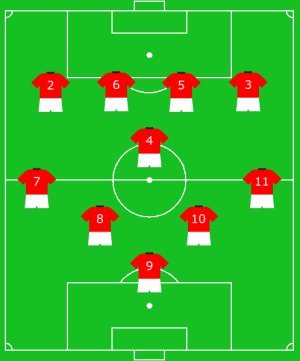Early in the life of this blog, we elaborated – or tried to, at any rate – on the things about squad numbers which got our goat. It’s not to suggest, by the way, that we’re perfect ourselves, as proven by the fact we once signed attacking midfielder Stefano Fiore for Roma in CM99-00 and gave him the vacant number 6 rather than 28.
It seems only fair, therefore, that we should welcome the upcoming festive season with a balancing article which looks at the things which don’t follow the ‘classic’ numbering pattern but for which we have a ‘grá’ [it’s an Irish word similar to ‘affection’, pronounced ‘graw’]. The fact that each example has a caveat helps to ease our conscience.
We’ll limit our own to three, but we’ll open the floor to suggestions:
1. Number 2 at centre-back (but only if 4 is right-back)
Ryan McGarrity entered my office. The Northern Irish youngster had performed well since breaking into the Cork City team, forming a strong partnership at centre-back with German international Jurgen Becker. I should point out at this stage in the story that it technically occurred in the setting of a game of Football Manager 2012.
Captain Nathan Todd was retiring. He only had the armband for a year and was only ever intended to be stopgap after the retirement of club stalwart Aiden Kelly, who had come up through the ranks and gone on to become the Republic of Ireland left-back as well as winning everything domestically and leading the club to the Champions League group stages.
As Todd was getting on in years, I decided to leave him in the number 13 shirt he had made his own in proving a highly dependable back-up for Kelly or else playing in front of him at midfield. That was fine, but McGarrity was going to be the new captain, hopefully for more than a decade, so he couldn’t keep 17. Becker wore 5 and Lars Larsson, a D/DM C of high quality, was still an important squad member despite getting on and I couldn’t just take 4 off him. There was another vacant number, though.
“You’re the new captain,” I told McGarrity, “and you’re also the new number 2.”
“Am I moving to right-back?” he asked, incredulously.
“No, you’re staying where you are but I can’t have my long-term captain wearing a number higher than 11. You’d end up riding team-mates’ former girlfriends, parking in spaces reserved for disabled drivers and getting up to no good in general.”
Kasado was the first-choice right-back and kept number 22 until Larsson left at the age of 35. The Brazilian was also capable of playing centre-back and so 4 was a good fit for him. Most of the rest of the first team wore the ‘right’ numbers though and so, in some European games, when Larsson would come on for Swiss playmaker Adolfo Cappelletti as we switched to 4-1-4-1, the right-back was nominally number 10. It was an occupational hazard.
Apart from fictional examples, Argentina haven’t done too badly with 4 at right-back and 2 in the middle, while it worked out okay too for Liverpool in the 1980s.
2. Number 9 in the hole behind a strikeforce of 8 and 10
The ‘three foreigners’ rule came against Barcelona in the 1994 Champions League final as Johan Cruyff had to drop Michael Laudrup to accommodate Ronald Koeman, Hristo Stoichkov and Romario. Without limitations, the Spanish side may have put up more of a fight against AC Milan, who beat them 4-0, but then maybe Milan might have had better foreigners too.
In La Liga, however, Barça played some lovely stuff. While they took the title based on their head-to-head record with Deportivo La Coruña, the sides were 10 clear of third-placed Real Zaragoza and this was with only two points for a win – had it been three then Cruyff’s side would have won the title.
With no restrictions on foreigners, Laudrup provided the bullets for Stoichkov and Romario, who had arrived from PSV Eindhoven. The Dane retained the number 9 he had worn in a more advanced role with Romario taking 10 and it just looked right – we wouldn’t have been as keen on, say, 8 and 11 or 7 and 10. Honourable mention for Arsenal in 1996-97, with Paul Merson playing behind Ian Wright and Denis Bergkamp.
3. Number 7 in central midfield but only if 8 or 10 plays on the right
Bryan Robson is mentioned a fair bit in this piece about Manchester United number 7s and he’s the first example of this trope who springs to mind.
We can’t exactly say why, but we like the look of a 7 being an all-round, domineering midfield, possibly more so than one in the playmaking role, though that fits fine too.
If 4 or 6 were moved to the right to accommodate this, then the OCD alarm might begin to sound, likewise 11 as it would mean another central number moving across to the left. A small amount of ‘wrong’ numbers is bearable, but don’t go too far with it.













